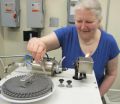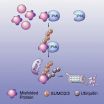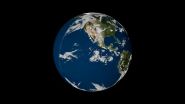Caught by a hair
Diane Beauchemin has developed a cutting-edge forensic tool that could help catch criminals
2014-05-29
(Press-News.org) Crime fighters could have a new tool at their disposal following promising research by Queen's professor Diane Beauchemin.
Dr. Beauchemin (Chemistry) and student Lily Huang (MSc'15) have developed a cutting-edge technique to identify human hair. Their test is quicker than DNA analysis techniques currently used by law enforcement. Early sample testing at Queen's produced a 100 per cent success rate.
"My first paper and foray into forensic chemistry was developing a method of identifying paint that could help solve hit and run cases," explains Dr. Beauchemin. "Last year, Lily wanted to research hair analysis, so I started working in that area."
Blood samples are often used to identify gender and ethnicity, but blood can deteriorate quickly and can easily be contaminated. Hair, on the other hand, is very stable. Elements in hair originate from sweat secretions that alter with diet, ethnicity, gender, the environment and working conditions.
Dr. Beauchemin's process takes 85 seconds to complete and involves grinding up the hair, burning it and then analyzing the vapour that is produced.
"Our analysis process is very robust and can be used universally," says Ms. Huang. "One of our samples even included dyed hair and the test was 100 per cent accurate. The test was able to distinguish East Asians, Caucasians and South Asians."
Dr. Beauchemin says she has contacted law enforcement agencies about using the new technology. She is also planning to collect more hair samples and continue her research with a goal of pinpointing where exactly in the world the hair sample is from, to look for more ethnicities and determine specific age.
INFORMATION:The research was published in the latest edition of Chemistry World.
ELSE PRESS RELEASES FROM THIS DATE:
Neural transplant reduces absence epilepsy seizures in mice
2014-05-29
New research from North Carolina State University pinpoints the areas of the cerebral cortex that are affected in mice with absence epilepsy and shows that transplanting embryonic neural cells into these areas can alleviate symptoms of the disease by reducing seizure activity. The work may help identify the areas of the human brain affected in absence epilepsy and lead to new therapies for sufferers.
Absence epilepsy primarily affects children. These seizures differ from "clonic-tonic" seizures in that they don't cause muscle spasms; rather, patients "zone out" or stare ...
Drop in global malnutrition depends on ag productivity, climate change
2014-05-29
WEST LAFAYETTE, Ind. - Global malnutrition could fall 84 percent by the year 2050 as incomes in developing countries grow - but only if agricultural productivity continues to improve and climate change does not severely damage agriculture, Purdue University researchers say.
"The prevalence and severity of global malnutrition could drop significantly by 2050, particularly in the poorest regions of the world," said Thomas Hertel, Distinguished Professor of Agricultural Economics. "But if productivity does not grow, global malnutrition will worsen even if incomes increase. ...
Penn study shows how misfolded proteins are selected for disposal
2014-05-29
PHILADELPHIA – It's almost axiomatic that misfolded proteins compromise how cells normally function and cause debilitating human disease, but how these proteins are detected and degraded within the body is not well understood. Neurodegenerative diseases – including Alzheimer's disease, Parkinson's disease, amyotrophic lateral sclerosis (Lou Gehrig's disease), Huntington's disease, and spinocerebellar ataxias – exact a devastating toll on aging populations throughout the world.
"Yet, there is virtually no cure for any of these diseases, and clinical trials have yielded ...
Tropical Storm Amanda gets bisected and animated by NASA's CloudSat
2014-05-29
VIDEO:
This animation shows how Cloudsat was able to get the image shown.
Click here for more information.
Tropical Storm Amanda continues to weaken in the eastern Pacific from dry air and wind shear. NASA's CloudSat satellite captured a view of the storm from the side revealing heavy precipitation when the storm was the most powerful May Eastern Pacific on record.
NASA's CloudSat satellite flew over Hurricane Amanda in the east Pacific on May 25, 2014 at 2100 UTC (5 p.m. EDT) ...
An ecological risk research agenda for synthetic biology
2014-05-29
Washington — Environmental scientists and synthetic biologists have for the first time developed a set of key research areas to study the potential ecological impacts of synthetic biology, a field that could push beyond incremental changes to create organisms that transcend common evolutionary pathways.
The Synthetic Biology Project at the Wilson Center and the Program on Emerging Technologies at the Massachusetts Institute of Technology convened the interdisciplinary group of scientists and are releasing the report, Creating a Research Agenda for the Ecological Implications ...
Engineering a better way to rebuild bone inside the body
2014-05-29
Traumatic bone injuries such as blast wounds are often so severe that the body can't effectively repair the damage on its own. To aid the recovery, clinicians inject patients with proteins called growth factors. The treatment is costly, requiring large amounts of expensive growth factors. The growth factors also disperse, creating unwanted bone formation in the area around the injury.
A new technology under development at the Georgia Institute of Technology could one day provide more efficient delivery of the bone regenerating growth factors with greater accuracy and ...
Improved identification of war wound infections promises more successful treatment
2014-05-29
War wounds that heal successfully frequently contain different microbial species from those that heal poorly, according to a paper published ahead of print in the Journal of Clinical Microbiology. These and other findings have important implications for improving wound healing, says first author Nicholas Be of Lawrence Livermore National Laboratory, Livermore, California.
The problem the researchers were addressing is that culture-based identification, which has been used to assay war wound infections, misses the many species that are difficult or impossible to culture. ...
Huge tooth fossil shows marine predator had plenty to chew on
2014-05-29
A fossilised tooth belonging to a fearsome marine predator has been recorded as the largest of its kind found in the UK, following its recent discovery.
A team of palaeontologists have verified the tooth, which was found near Chesil Beach in Dorset, as belonging to a prehistoric relative of modern crocodiles known as Dakosaurus maximus.
The tooth, which has a broken tip, is approximately 5.5 cm long.
Researchers and curators from University of Edinburgh and the Natural History Museum in London identified the item after it was bought at an online auction by a fossil ...
Amber discovery indicates Lyme disease is older than human race
2014-05-29
CORVALLIS, Ore. – Lyme disease is a stealthy, often misdiagnosed disease that was only recognized about 40 years ago, but new discoveries of ticks fossilized in amber show that the bacteria which cause it may have been lurking around for 15 million years – long before any humans walked on Earth.
The findings were made by researchers from Oregon State University, who studied 15-20 million-year-old amber from the Dominican Republic that offer the oldest fossil evidence ever found of Borrelia, a type of spirochete-like bacteria that to this day causes Lyme disease. They ...
Remember parathyroid hormone as well as vitamin D to assess vitamin's role in diabetes
2014-05-29
TORONTO -- Combined assessment of parathyroid hormone along with vitamin D may be needed to assess the impact of vitamin D status on sugar metabolism, according to Toronto researchers. Their study is published on-line in Diabetes on May 29 2014.
The new findings might explain why studies of vitamin D alone have been conflicting and why clinical trials of vitamin D supplementation to improve diabetes have been disappointing, says principal investigator Dr. Ravi Retnakaran. He is a clinician-scientist at the Lunenfeld-Tanenbaum Research Institute at Mount Sinai Hospital ...
LAST 30 PRESS RELEASES:
Injectable breast ‘implant’ offers alternative to traditional surgeries
Neuroscientists devise formulas to measure multilingualism
New prostate cancer trial seeks to reduce toxicity without sacrificing efficacy
Geometry shapes life
A CRISPR screen reveals many previously unrecognized genes required for brain development and a new neurodevelopmental disorder
Hot flush treatment has anti-breast cancer activity, study finds
Securing AI systems against growing cybersecurity threats
Longest observation of an active solar region
Why nail-biting, procrastination and other self-sabotaging behaviors are rooted in survival instincts
Regional variations in mechanical properties of porcine leptomeninges
Artificial empathy in therapy and healthcare: advancements in interpersonal interaction technologies
Why some brains switch gears more efficiently than others
UVA’s Jundong Li wins ICDM’S 2025 Tao Li Award for data mining, machine learning
UVA’s low-power, high-performance computer power player Mircea Stan earns National Academy of Inventors fellowship
Not playing by the rules: USU researcher explores filamentous algae dynamics in rivers
Do our body clocks influence our risk of dementia?
Anthropologists offer new evidence of bipedalism in long-debated fossil discovery
Safer receipt paper from wood
Dosage-sensitive genes suggest no whole-genome duplications in ancestral angiosperm
First ancient human herpesvirus genomes document their deep history with humans
Why Some Bacteria Survive Antibiotics and How to Stop Them - New study reveals that bacteria can survive antibiotic treatment through two fundamentally different “shutdown modes”
UCLA study links scar healing to dangerous placenta condition
CHANGE-seq-BE finds off-target changes in the genome from base editors
The Journal of Nuclear Medicine Ahead-of-Print Tip Sheet: January 2, 2026
Delayed or absent first dose of measles, mumps, and rubella vaccination
Trends in US preterm birth rates by household income and race and ethnicity
Study identifies potential biomarker linked to progression and brain inflammation in multiple sclerosis
Many mothers in Norway do not show up for postnatal check-ups
Researchers want to find out why quick clay is so unstable
Superradiant spins show teamwork at the quantum scale
[Press-News.org] Caught by a hairDiane Beauchemin has developed a cutting-edge forensic tool that could help catch criminals






